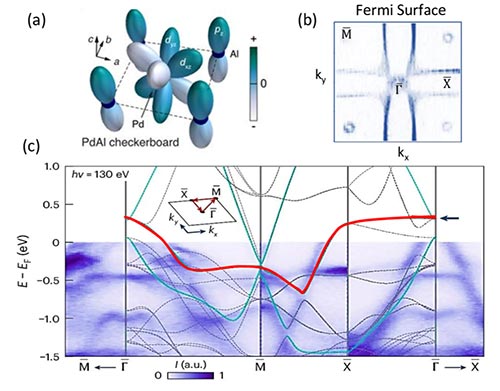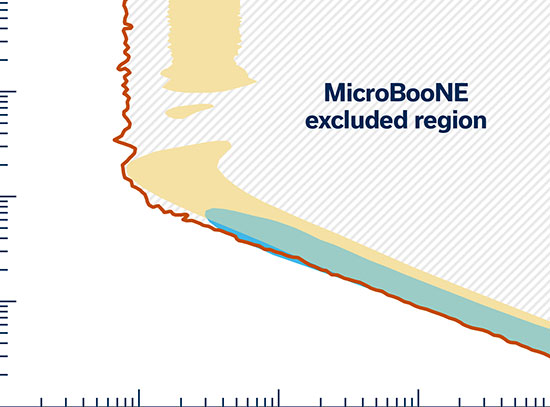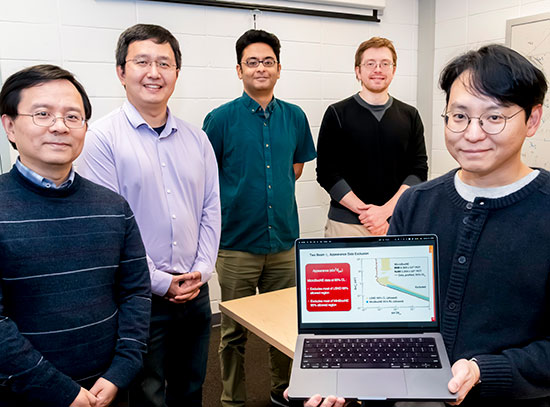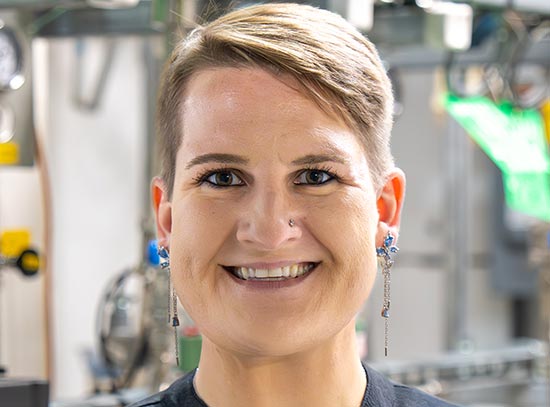Orbital-Driven Frustrated Electron Hopping in a 2D Lattice
October 16, 2025
 enlarge
enlarge
a) Orbital orientation of PdAl layer in Pd5AlI2 forms a checkerboard lattice. (b & c) ARPES Fermi surface map and band structure (blue) along the  path (inset; red) of the surface BZ. DFT calculated band structure is overlaid on top (dashed grey) with bands linked to the decorated checkerboard model highlighted in cyan and red.
path (inset; red) of the surface BZ. DFT calculated band structure is overlaid on top (dashed grey) with bands linked to the decorated checkerboard model highlighted in cyan and red.
The Science
Scientists show that Pd5AlI2 can mimic the electronic behavior of frustrated lattices, creating both flat and Dirac-like bands from a simple square lattice.
The Impact
This work reveals a new way to achieve the exotic electronic properties of frustrated lattices in simple, stable materials, opening paths to discover and design novel quantum materials.
Summary
Electron hopping on periodic lattice structures leads to unusual electronic behavior. In particular, hopping on two-dimensional frustrated lattices such as kagome, dice, and Lieb creates band structures that include both massless, Dirac-like bands and flat ( dispersionless) bands. Since real materials with dice and Lieb lattices are rare and their experimental realization has so far been limited to optical lattices of ultracold atoms, researchers have proposed another approach: using the arrangement of atomic orbitals to reproduce the same frustrated hopping seen in these lattices. This method could expand the range of materials that show frustrated electron hopping, though it has not yet been demonstrated in practice.
In this work, frustrated electron hopping has been shown in the van der Waals intermetallic compound Pd5AlI2, arising from the specific orientation of atomic orbitals in a simple square lattice. Using angle-resolved photoemission spectroscopy and quantum oscillation experiments, researchers found that Pd5AlI2 has linear Dirac-like bands cut by a locally flat band at their crossing point, which is a key feature of dice, Lieb and checkerboard lattices. In addition, this compound is chemically stable, and its unusual metallic band structure survives in air even down to a single layer. The exfoliable nature of these materials enables access to the monolayer limit, opening new avenues for probing correlated orbital physics in the true 2D regime.
These findings demonstrate a new way to realize the electronic structures typical of frustrated lattices within systems that are not geometrically frustrated.
Download the research summary slide (PDF)
Related Links
Paper: Frustrated electron hopping from the orbital configuration in a two-dimensional lattice
Contact
Aravind Devarakonda
Columbia University
aravind.devarakonda@columbia.edu
Abhay N. Pasupathy
Columbia University
apn2108@columbia.edu
Raquel Queiroz
Columbia University
raquel.queiroz@columbia.edu
Cory R. Dean
Columbia University
cd2478@columbia.edu
Xavier Roy
Columbia University
xr2114@columbia.edu
Publications
A. Devarakonda, C. S. Koay, D. G. Chica, M. Thinel, A. K. Kundu, Z. Lin, A. B. Georgescu, S. Rossi, S. Y. Han, M. E. Ziebel, M. A. Holbrook, A. Rajapitamahuni, E. Vescovo, K. Watanabe, T. Taniguchi, M. Delor, X. Zhu, A. N. Pasupathy, R. Queiroz, C. R. Dean, X. Roy. “Frustrated electron hopping from the orbital configuration in a two-dimensional lattice.” Nat. Phys. 21, 1260–1266 (2025). https://doi.org/10.1038/s41567-025-02953-2
Funding
Research was conducted as part of the Programmable Quantum Materials, an Energy Frontier Research Center, funded by the US Department of Energy (DOE), Office of Science, Basic Energy Sciences, under award no. DE-SC0019443 (X.R., C.R.D., A.N.P., R.Q., X.Z. and M.D.). X.R. acknowledges support from a Brown Investigator Award, a program of the Brown Institute for Basic Sciences at the California Institute of Technology. The synthesis and structural characterization of the 2D metal were supported by the NSF MRSEC program through the Center for Precision-Assembled Quantum Materials at Columbia University, award no. DMR-2011738 (X.R., C.R.D., A.N.P. and X.Z.). X.Z. acknowledges support for STM/STS experiments by the Air Force Office of Scientific Research under award no. FA9550-22-1-0389. The Physical Property Measurement System used to perform vibrating-sample magnetometry and electrical transport measurements was purchased with financial support from the National Science Foundation through a supplement to award no. DMR-1751949 (X.R.). A.D. acknowledges support from the Simons Foundation Society of Fellows (grant no. 855186). High-magnetic-field measurements were performed at the National High Magnetic Field Laboratory, supported by the National Science Foundation Cooperative Agreement no. DMR-1644779 and the State of Florida. ARPES measurements used resources at the 21-ID (Electron Spectro-Microscopy) beamline of the National Synchrotron Light Source II, a US DOE, Office of Science User Facility, operated for the DOE, Office of Science, Brookhaven National Laboratory, under contract no. DE-SC0012704.
2025-22673 | INT/EXT | Newsroom









